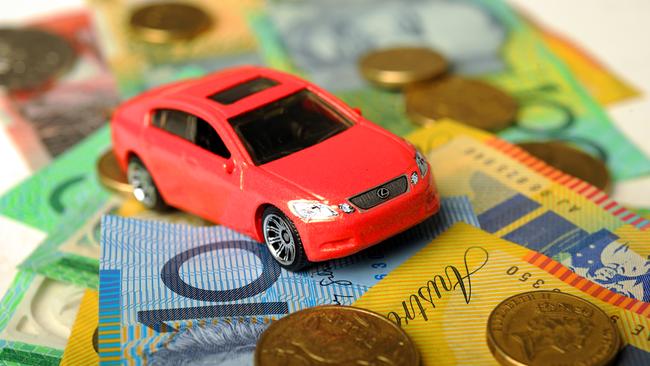Put the brakes on the rising cost of keeping a car
Petrol prices are near record highs, car insurance is climbing, and servicing costs sting household finances. Try these tips to save money on running your car.
Car running expenses are one of the biggest financial drains on most households and the cost is accelerating.
Whether it’s seesawing petrol prices jumping above $1.70 a litre or surging car insurance premiums going unnoticed, price pain is real, but motorists have opportunities to control their spending.
Australian Bureau of Statistics inflation data shows insurance costs alone have jumped 50 per cent in the past decade, while petrol price swings in some cities are blowing out.
In capital cities with petrol price cycles, the difference between buying on a cheap day and an expensive day can now be 40c to 50c. So filling a family car can cost you $30 extra each tank if you’re just one day late with your timing.
Budgeting specialist David Rankin, the founder of Sort My Money, said households with more than one vehicle could save the most money by ditching one set of wheels where possible.
This would halve costs such as insurance, registration, tyres, repairs and maintenance, he said.
“It’s ongoing savings lifestyle-wise if you can afford to run on one car.”
For other households, there are still plenty of ways to put the brakes on rising car running costs.
“It’s such a big-ticket item in your budget and it’s really important to be across all the costs associated with a car,” Mr Rankin said.
PETROL
Australian Competition and Consumer Commission chairman Rod Sims said petrol price cycles were prominent in Australia’s five biggest capital cities.
“Buy petrol at the lowest trough of the cycle if you can,” Mr Sims said.
“If you have to fill up, just put a bit of petrol in and wait until prices are on the way down again.”
Mr Sims said motorists in all cities should consider shopping at independent fuel retailers.
“Regular unleaded petrol is essentially the same, and the independents are consistently priced the cheapest,” he said.

There are several online apps and websites that help people compare petrol retailers’ prices, but make sure you factor in your time and travel costs if chasing cheaper fuel.
Motorists can also save money on petrol by running their car more efficiently, including:
• Gentle acceleration and braking.
• Using airconditioning wisely.
• Keeping tyres correctly inflated in line with manufacturer guidelines.
• Avoiding short trips, as car engines can consume 20 per cent more petrol when cold.
• Maintaining steady cruising speeds and using cruise control if you have it.
INSURANCE
Car insurance has had the biggest cost increase of all vehicle-related expenses since 2009, and motorists who fail to check their premiums or ask for a better deal could miss out on hundreds of dollars a year.
A new analysis by comparison website Finder.com.au compared 1000 insurance quotes from 38 companies and found the average difference between the cheapest and most expensive comprehensive policies was $664 a year.
It found people in their 20s paid almost $2200 a year on average, while someone aged 50 to 60 paid less than $800.
Finder insurance spokesman Taylor Blackburn said the savings could be huge for those who shopped around.
“An insurer that offers the best deal during your 20s might not do so a few years down the track,” he said.
But people should not compare car insurance on price alone, Mr Blackburn said.
“Take note of other features that really add up, like roadside assistance, new-for-old replacement, and whether they offer agreed or market value in the event of a claim.
“If you’re looking to reduce your annual car insurance premium, you could consider a higher excess, but make sure you can afford to cough up that higher amount if you were to make a claim.”

MAINTENANCE
The cost of car maintenance and repairs has increased 18 per cent in the past decade, according to the Bureau of Statistics, but it’s still below the overall rise in consumer price inflation of 23 per cent.
Mr Rankin said he expected servicing costs to climb disproportionately in the coming years because fewer people were buying new cars, leading to an ageing national fleet.
“Look at where you are getting your car serviced,” he said.
If it’s not under warranty and you are not obliged to go with your car dealer’s servicing department, look around for a better price.
Independent mechanics do logbook services too, often at cheaper prices.
“You can get great deals,” Mr Rankin said.
“Don’t feel like you are tied to a supplier. A lot of people don’t realise that they can shop around.”
Tyres are another big cost that pop up every couple of years.
“Be aware of where you are at with the tyres because it’s a primary safety concern,” Mr Rankin said.
He suggested setting up a separate bank account to cover big car expenses such as tyres and registration: “$20 a week gives you $1000 a year”.
“When they come around they could really set you back if you have not planned for them.”
Mr Rankin said when paying annual registration or insurance fees, people should pay monthly or quarterly where this was offered – even if this cost a little more – because it smoothed out household spending.
“It’s about how much money you’ve got in the bank right now. If you can pay monthly or quarterly rather than annually it’s better for cash flow.”
Originally published as Put the brakes on the rising cost of keeping a car
